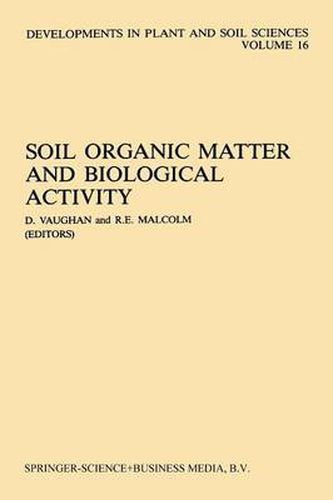Readings Newsletter
Become a Readings Member to make your shopping experience even easier.
Sign in or sign up for free!
You’re not far away from qualifying for FREE standard shipping within Australia
You’ve qualified for FREE standard shipping within Australia
The cart is loading…






This title is printed to order. This book may have been self-published. If so, we cannot guarantee the quality of the content. In the main most books will have gone through the editing process however some may not. We therefore suggest that you be aware of this before ordering this book. If in doubt check either the author or publisher’s details as we are unable to accept any returns unless they are faulty. Please contact us if you have any questions.
It has long been recognized that soil organic matter is the key to soil fertility. As a nutrient store it gradually provides essential elements which the soil cannot retain for long in inorganic form. It buffers growing plants against sudden changes in their chemical environment and preserves moisture in times of drought. It keeps the soil in a friable, easily penetrated physical condition, well-aerated and free draining, providing young seedlings with an excellent medium for growth. But it has another property, the nature and extent of which have been the subject of argu ment and controversy ever since scientists began to study the soil, and that is its ability to affect growth directly, other than by providing nutrient elements. Any one wishing to learn about these effects has been faced with a daunting mass of literature, some confusing, often contradictory, and spread through a multitude of journals. Individual aspects have been covered from time to time in reviews but there has obviously been a need for a modern authoritative text book dealing with the many facets of this subject, so the publication of this volume is timely. The editors and authors are all specialists in their fields, fully familiar with the com plex nature of soil organic matter and with the particular difficulties arising in any study of its properties. Where controversies exist they have presented all sides of the argument and have highlighted areas where further work is badly needed.
$9.00 standard shipping within Australia
FREE standard shipping within Australia for orders over $100.00
Express & International shipping calculated at checkout
This title is printed to order. This book may have been self-published. If so, we cannot guarantee the quality of the content. In the main most books will have gone through the editing process however some may not. We therefore suggest that you be aware of this before ordering this book. If in doubt check either the author or publisher’s details as we are unable to accept any returns unless they are faulty. Please contact us if you have any questions.
It has long been recognized that soil organic matter is the key to soil fertility. As a nutrient store it gradually provides essential elements which the soil cannot retain for long in inorganic form. It buffers growing plants against sudden changes in their chemical environment and preserves moisture in times of drought. It keeps the soil in a friable, easily penetrated physical condition, well-aerated and free draining, providing young seedlings with an excellent medium for growth. But it has another property, the nature and extent of which have been the subject of argu ment and controversy ever since scientists began to study the soil, and that is its ability to affect growth directly, other than by providing nutrient elements. Any one wishing to learn about these effects has been faced with a daunting mass of literature, some confusing, often contradictory, and spread through a multitude of journals. Individual aspects have been covered from time to time in reviews but there has obviously been a need for a modern authoritative text book dealing with the many facets of this subject, so the publication of this volume is timely. The editors and authors are all specialists in their fields, fully familiar with the com plex nature of soil organic matter and with the particular difficulties arising in any study of its properties. Where controversies exist they have presented all sides of the argument and have highlighted areas where further work is badly needed.